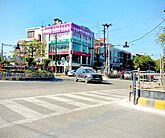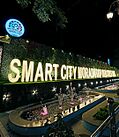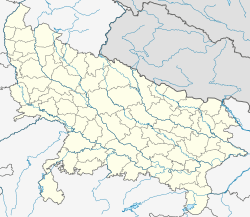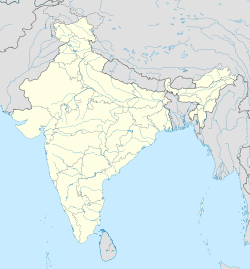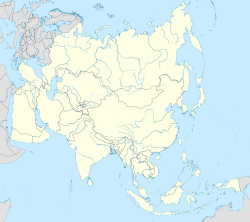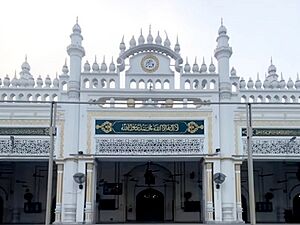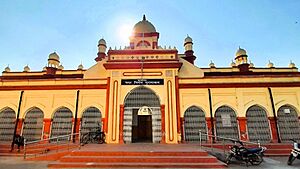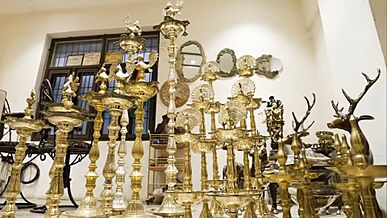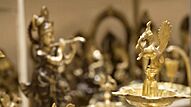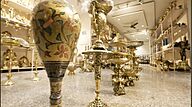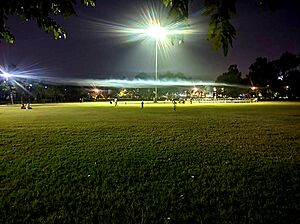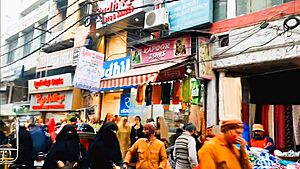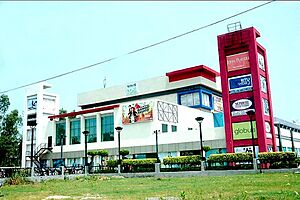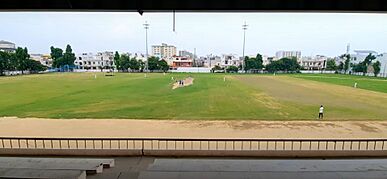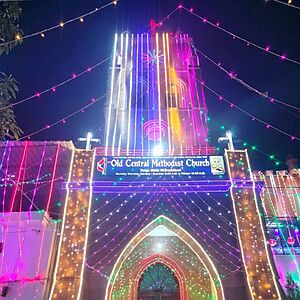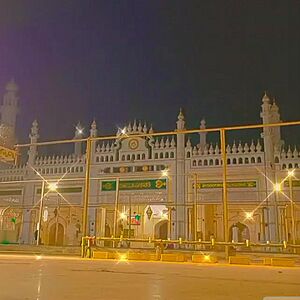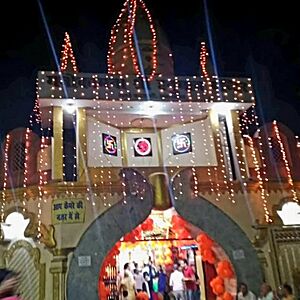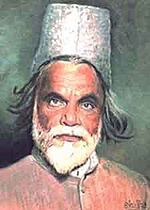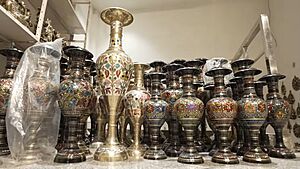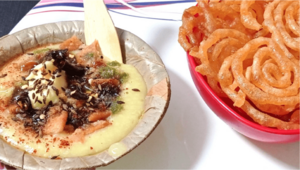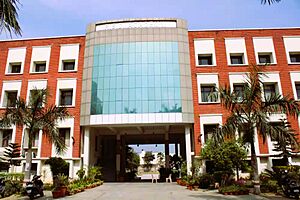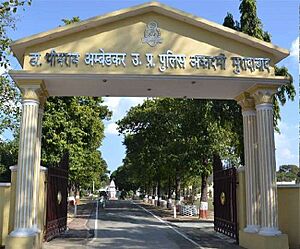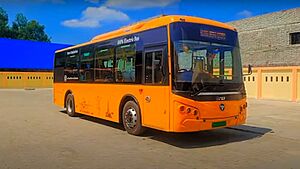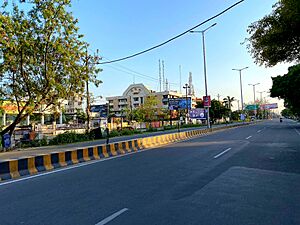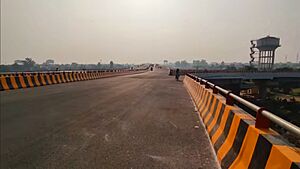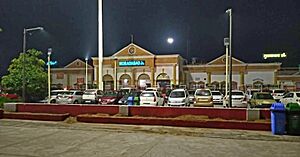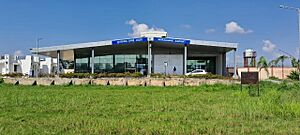Moradabad facts for kids
Quick facts for kids
Moradabad
|
|
|---|---|
|
City
|
|
|
New Moradabad Skyline
Pili Kothi Chowk
Pilikothi Welcome Sign
Sai Mandir
Philips Memorial Methodist Church
Jama Masjid
Moradabad Railway Station
Moradabad Entry Gate (Zero Point)
|
|
| Nickname(s):
Brass City
|
|
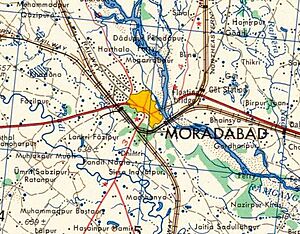
An old map of Moradabad (1955)
|
|
| Country | |
| State | |
| District | Moradabad |
| Established | 1625 |
| Named for | Murad Bakhsh |
| Area | |
| • Total | 79 km2 (31 sq mi) |
| Elevation | 198 m (650 ft) |
| Population
(2011)
|
|
| • Total | 889,810 |
| • Density | 11,260/km2 (29,170/sq mi) |
| Demonym(s) | Moradabadi |
| Languages | |
| • Official | Hindi, Urdu |
| Time zone | UTC+5:30 (IST) |
| PIN |
244001
|
| Telephone code | 0591 |
| Vehicle registration | UP-21 |
Moradabad is a busy city in the Indian state of Uttar Pradesh. It's located on the banks of the Ramganga river. The city is about 165 kilometers (103 miles) from New Delhi, India's capital. It's also about 356 kilometers (221 miles) northwest of Lucknow, the state capital.
According to the 2011 census, Moradabad is the 10th most populated city in Uttar Pradesh. It's also the 54th most populated city in all of India. It's a very important center in the Western UP region. People come here for jobs, education, industry, culture, and government services.
Moradabad is often called Pital Nagri, which means "Brass City." This is because it's famous for its beautiful brass handicrafts. These items are sold all over the world. In recent years, the city has also started working with other metals like aluminum, steel, and iron. In 2014, a financial newspaper called Livemint listed Moradabad as one of "25 emerging cities to watch out for by 2025."
The city is also part of the National Smart Cities Mission. This means it's one of 100 cities being modernized by the Indian government.
Over its 400-year history, Moradabad has been ruled by many different groups. It was part of the Delhi Sultanate, then the Mughal Empire. Later, it joined the Kingdom of Rohilkhand in 1742. In 1774, it came under the control of Oudh State. Finally, in 1801, it was given to the British East India Company. The British then made Moradabad the main city of its district.
Moradabad got its first railway connections in the late 1800s. A line to Chandausi was built in 1872. It was extended to Bareilly in 1873. More lines were added over the years, connecting Moradabad to other important cities. Today, it's a major railway hub and the headquarters for the Moradabad division of Northern Railway.
Contents
- How Moradabad Got Its Name
- A Look at Moradabad's Past
- Moradabad's Location and Environment
- Weather in Moradabad
- People of Moradabad
- How Moradabad is Governed
- Moradabad's Economy
- City Life in Moradabad
- Sports in Moradabad
- Moradabad's Culture
- Learning in Moradabad
- Provincial Armed Constabulary (PAC)
- Getting Around Moradabad
- Media in Moradabad
- Challenges Faced by Moradabad
- Famous People from Moradabad
- See also
How Moradabad Got Its Name
Moradabad was founded in 1625 by Rustam Khan. He was a governor under the Mughal emperor Shah Jahan. The city is named after Prince Murad Bakhsh. He was the youngest son of Emperor Shah Jahan.
The area was first known as Chaupala. Rustam Khan took control of it in 1624. He then renamed it "Rustamnagar" after himself.
However, the name Rustamnagar didn't last long. Emperor Shah Jahan was not happy that Rustam Khan had gone beyond his orders. To make the emperor happy, Rustam Khan quickly renamed the city Muradabad. He named it in honor of the young Prince Murad Bakhsh. The emperor was pleased. He allowed Rustam Khan to remain in charge of the new city. Since then, the name Muradabad (or Moradabad) has been used.
A Look at Moradabad's Past
Early Days: Delhi Sultanate (12th–16th Century)
Moradabad was originally part of the Katehr region. It was a strong area for the Katheria Rajputs. These Rajputs were known for fighting against their Muslim rulers. Because of this, the rulers often attacked and looted the region.
Between 1200 and 1424, different rulers from the Delhi Sultanate attacked the area many times. They wanted to destroy it completely. But the Katheria Rajputs were good at hiding in the jungles. The fighting stopped in 1424. That's when Khizr Khan, a leader of the Khilji dynasty, died. Har Singh, a Katheria leader, then agreed to follow the Delhi Sultanate's rule. After that, the region was mostly peaceful for about 200 years.
Mughal Empire (1539–1742)
In 1530, the Katehr region came under the Mughal Empire. But Emperor Humayun soon lost control. The region was then taken over by Sher Shah Suri of the Sur Empire. It stayed under Sur rule for 16 years. Then Humayun took it back.
Under the Mughal Empire, Moradabad city was called Chaupala. It was part of the Mugalpura area. This area was known for producing a lot of money for the empire. It also provided soldiers for the Mughal army.
A very important event happened in Moradabad's history in 1624. A Katheria leader named Raja Ram Singh attacked the Tarai region. The ruler of Kumaon complained to Emperor Shah Jahan. The emperor sent his general, Rustam Khan Dakhani, to handle the problem. Rustam Khan captured Chaupala and killed Ram Singh. He then rebuilt the city and named it Rustamnagar. He built a new fort and a large mosque, the Jama Masjid, by the Ramganga river. He moved the capital from Sambhal to this new city. This Jama Masjid was the first one built by a river. It is still standing today.
However, Shah Jahan was not happy with Rustam Khan's actions. He called Rustam to his court. He asked why Rustam had gone beyond his orders. Rustam Khan quickly said he had named the city Muradabad. He named it in honor of Prince Murad Bakhsh, Shah Jahan's son. The emperor was satisfied. He allowed Rustam Khan to stay in charge of the city.
Rohilkhand State (1742–1774)
In the 1730s, many Afghan tribes, called Rohillas, came to India. They were escaping an invasion in Afghanistan. They settled in the Katehr region, including Moradabad. One Rohilla leader, Ali Mohammed Khan, gained a lot of land. He became a Nawab (ruler) under the protection of Moradabad's Mughal governor. In 1742, he founded the Rohilkhand state. This state included Moradabad and other nearby areas. The region did well under the Rohillas. But later, invaders called Marathas attacked and damaged Moradabad.
Oudh State (1774–1801)
The Nawab of Oudh, Shuja-ud-Daula, helped the Rohillas against the Marathas. In return, the Rohillas were supposed to pay him a large sum of money. The Nawab kept his promise, but the Rohillas did not pay. So, the Nawab of Oudh claimed the entire Rohilkhand region. He started taking over its cities, including Moradabad, in 1774. By this time, Moradabad was already in bad shape from the Maratha invasion. Under Oudh rule, its condition got even worse.
British Empire (1801–1947)
The Oudh state owed a lot of money to the British Empire. To pay off these debts, Oudh gave the entire Rohilkhand region to the British in 1801. This brought Moradabad under British control. The city's economy got even worse under British rule. The British policies did not help the local landowners. This caused a lot of unhappiness among the people.
The average income and wages also dropped a lot. This made workers very unhappy. All this anger led to the rebellion of 1857.
The Rebellion of 1857
During the Indian Rebellion of 1857, British officers had to leave Moradabad. The rebels formed their own government. In Moradabad, not just soldiers but also ordinary people supported the rebellion. They were angry about the British rule.
On May 15, 1857, there was a big fight between rebel soldiers and British forces. Three days later, on May 19, the rebellion spread to more soldiers. The district jail was broken open, and many prisoners escaped.
News of the rebellion in Bareilly reached Moradabad on May 8. Immediately, soldiers took over the British treasury. British officers and their families had to escape. Those who didn't were killed. Nawab Majju Khan, a rebel leader, became the new governor of Moradabad. He ruled until June 23, when he was overthrown by Asad Ali Khan. Asad Ali Khan was helping the British. But even with a new leader, there was still a lot of anger against the British. So, violence continued in the city.
A year later, on April 21, 1858, the British returned with a larger force. They started capturing freedom fighters. Those captured were treated very harshly. Nawab Majju Khan was also captured and killed. On April 30, 1858, British rule was re-established in Moradabad.
Fight for Independence
Moradabad played a big part in the Civil Disobedience and Quit India Movements. These movements were started by Mahatma Gandhi. The Civil Disobedience Movement was planned at a meeting in Moradabad in 1920. Many important leaders like Pt. Nehru and Sarojini Naidu attended. When the movement began in 1932, people in Moradabad protested against unfair arrests.
The Quit India Movement saw a lot of violence in Moradabad. In one incident, six people were killed and over 200 were hurt when police fired on protesters. More protests followed as people continued to fight against British rule.
After Independence (1947–Present)
India became independent in 1947. Moradabad became part of the new country. The city was developed to improve people's lives. It was mostly peaceful for over 30 years. However, a major conflict between different communities happened in 1980.
1980 Community Conflict
A significant community conflict occurred in Moradabad in 1980. It started on August 13, 1980, during Eid-al-Fitr prayers. A rumor about a stray animal entering the prayer ground led to arguments between people and the police. This resulted in stone-pelting and police firing. Many people were killed and injured. The violence spread to nearby cities. It took several months for things to return to normal.
Moradabad's Location and Environment
<mapframe latitude="28.829035" longitude="78.773346" zoom="12" width="200" height="300" text="A map of the city" align="left" />Moradabad is in the western part of Uttar Pradesh. It covers an area of 79 square kilometers (30 square miles). The city is located in the upper part of the Ganga plains. It is surrounded by smaller towns and villages. Moradabad is in a Seismic Zone IV, which means it can experience earthquakes.
The city has a lot of underground water. It is 198 meters (650 feet) above sea level. The Ramganga river, which flows into the Ganges, runs through the city. Another small river, Gagan, also flows here. These rivers are the main water sources.
Moradabad doesn't have many forests. But green areas have been created in many places. There are at least 29 trees in the city that are over 100 years old. These old trees are protected. Most of them are in the central Civil Lines area.
The soil in the city is fertile loam and clay loam.
Weather in Moradabad
Moradabad has a subtropical humid climate. This means it has hot summers and cool winters. It doesn't get much rain, except during the southwest monsoon season. The city experiences four main seasons: winter, spring, summer, monsoon, and fall.
The average highest temperature in the city is 30.4 °C (86.7 °F). The average lowest temperature is 18.7 °C (65.7 °F).
In summer, temperatures usually range from 24 °C to 40 °C (75 °F to 104 °F). In winter, they are between 5 °C to 20 °C (41 °F to 68 °F). May is the hottest month. January is the coldest. The highest temperature ever recorded was 48.2 °C (118.8 °F) on June 22, 1985. The lowest was 0.0 °C (32.0 °F) on January 12, 1983.
The city gets about 107.7 cm (42.4 inches) of rain each year. Most of this rain falls during July and August. August usually has the most rain. November has the least. The most rain in a single day was 40 cm (16 inches) on February 12, 1996.
| Climate data for Moradabad (1991–2020, extremes 1967–present) | |||||||||||||
|---|---|---|---|---|---|---|---|---|---|---|---|---|---|
| Month | Jan | Feb | Mar | Apr | May | Jun | Jul | Aug | Sep | Oct | Nov | Dec | Year |
| Record high °C (°F) | 28.5 (83.3) |
33.0 (91.4) |
39.4 (102.9) |
45.0 (113.0) |
45.5 (113.9) |
45.9 (114.6) |
44.0 (111.2) |
39.7 (103.5) |
39.0 (102.2) |
37.0 (98.6) |
34.7 (94.5) |
30.1 (86.2) |
48.2 (118.8) |
| Mean daily maximum °C (°F) | 19.0 (66.2) |
23.9 (75.0) |
29.6 (85.3) |
36.4 (97.5) |
38.9 (102.0) |
37.3 (99.1) |
33.4 (92.1) |
32.3 (90.1) |
31.8 (89.2) |
30.8 (87.4) |
26.7 (80.1) |
22.0 (71.6) |
30.3 (86.5) |
| Mean daily minimum °C (°F) | 8.4 (47.1) |
11.7 (53.1) |
16.3 (61.3) |
21.7 (71.1) |
25.1 (77.2) |
26.5 (79.7) |
26.1 (79.0) |
25.7 (78.3) |
24.6 (76.3) |
20.1 (68.2) |
14.6 (58.3) |
10.1 (50.2) |
19.4 (66.9) |
| Record low °C (°F) | 0.0 (32.0) |
2.0 (35.6) |
5.0 (41.0) |
10.0 (50.0) |
16.0 (60.8) |
17.0 (62.6) |
19.0 (66.2) |
14.0 (57.2) |
16.0 (60.8) |
12.1 (53.8) |
5.0 (41.0) |
2.0 (35.6) |
0.0 (32.0) |
| Average rainfall mm (inches) | 18.9 (0.74) |
24.7 (0.97) |
14.0 (0.55) |
7.0 (0.28) |
24.9 (0.98) |
111.0 (4.37) |
299.4 (11.79) |
319.4 (12.57) |
183.2 (7.21) |
28.5 (1.12) |
3.8 (0.15) |
8.8 (0.35) |
1,043.6 (41.09) |
| Average rainy days | 1.3 | 1.8 | 1.2 | 0.7 | 2.0 | 5.4 | 10.8 | 11.6 | 7.0 | 1.2 | 0.4 | 0.6 | 44.1 |
| Average relative humidity (%) (at 17:30 IST) | 71 | 59 | 48 | 36 | 40 | 55 | 75 | 81 | 77 | 64 | 61 | 67 | 61 |
| Source: India Meteorological Department | |||||||||||||
People of Moradabad
| Religions in Moradabad City (2011) | ||||
|---|---|---|---|---|
| Religion | Percent | |||
| Hinduism | 51.68% | |||
| Islam | 46.79% | |||
| Christianity | 0.61% | |||
| Sikhism | 0.43% | |||
| Other or not stated | 0.49% | |||
| Distribution of religions | ||||
Population Count
In 2011, Moradabad City had a population of 887,871 people. There were more males (464,580) than females (423,291). This means there were about 911 females for every 1000 males. The city's population grew by 25.25% between 2001 and 2011. About 10.45% of the population belongs to Scheduled Castes.
Children aged up to 6 years made up 13.08% of the population. There were 60,803 male children and 55,346 female children. This means there were about 910 female children for every 1,000 male children.
Religions in the City
Moradabad is a city where many different religions are practiced. Most people (51.68%) follow Hinduism. The second largest group (46.79%) follows Islam. Smaller numbers of people follow Christianity (0.61%), Sikhism (0.43%), Buddhism (0.03%), and Jainism (0.05%).
Languages Spoken
Most people in Moradabad speak and understand Hindi (over 81%). Urdu is the second most common language, spoken by over 18% of the people. The local way of speaking is called Khari Boli.
How Many People Can Read and Write?
In 2011, Moradabad had a literacy rate of 58.67%. This means over half the people could read and write. For males, the literacy rate was 72.21%. For females, it was 64.95%.
How Moradabad is Governed
City Management
The city of Moradabad is managed by the Moradabad Municipal Corporation. It's also known as Nagar Nigam Moradabad (NNM). It's one of only 17 such corporations in Uttar Pradesh. Before 1994, it was a smaller type of city council.
The Nagar Nigam is led by an elected Mayor. The mayor is chosen by the public for five years. Besides the mayor, 70 ward councillors are also elected. Each councillor represents a specific area of the city. There's also a permanent leader called the Municipal Commissioner. This person is in charge of the daily running of the city.
A special board meets regularly to plan for the city's development. This board includes the mayor, councillors, and other officials. They discuss issues and approve the city's budget. The Nagar Nigam handles things like:
- Street lighting
- Building and maintaining Roads
- Managing Water supply
- Registering births and deaths
- Developing gardens and public spaces
- Waste management
The Nagar Nigam gets money from the government. It also collects taxes like House Tax and Property Tax.
City Politics
Moradabad city is part of the Moradabad Lok Sabha constituency. This means it sends one representative, called an MP, to the national parliament. It also sends two representatives, called MLAs, to the state assembly.
The current MP is Ruchi Veera from the Samajwadi Party. She won in the 2024 elections. Because of the city's population, Muslim voters play a big role in its politics.
For the state assembly, the Moradabad Nagar area has often elected Hindu candidates. The current MLA for Moradabad Nagar is Ritesh Kumar Gupta from the BJP. The Moradabad Rural area, however, has mostly elected Muslim candidates. The current MLA for Moradabad Rural is Mohammed Nasir from the Samajwadi Party. These results show how politics can differ between city and rural areas.
Moradabad's Economy
Moradabad is a major industrial city in Uttar Pradesh. It's one of India's biggest places for exporting goods. The city's economy mainly depends on its brass and metalworks industry. This industry sells metal handicrafts to over 80 countries. More than 40% of all handicraft exports from India come from Moradabad.
Most of this industry is made up of small, informal businesses. This means they face challenges like getting loans or using new technology.
The industry creates many jobs. Estimates suggest between 150,000 and 800,000 people work as artisans and laborers. They are involved in making, packing, and decorating brass products. The brass industry has grown despite challenges like the COVID-19 pandemic.
In 2007, Moradabad's exports were worth ₹3,200 crores. By 2020, this had grown to ₹15,000 crores, with ₹10,000 crores from exports.
In 2018, about 75 brassware factories closed due to pollution rules. Then the Covid pandemic hit the industry hard. Because of this, manufacturers have started making items from other metals like iron, steel, and aluminium. This is helping Moradabad become a hub for all kinds of metalworks.
| Financial Year | Turnover (in crores of INR) | Export Turnover (in crores of INR) |
|---|---|---|
| 2007-08 | NA | 3,200 |
| 2011-12 | NA | 4,000 |
| 2017-18 | 9,700 | 5,400 |
| 2018-19 | 15,000 | 10,000 |
| 2019-20 | 8,500 | NA |
| 2020-21 | 9,500 | 7,000 |
| 2021-22 | 8,000 | 6,500 |
What is Manufactured?
Making brassware and other metalware is the biggest part of Moradabad's economy. It also provides the most jobs. Government records show over 9,000 registered factories. But industry groups believe there are between 30,000 and 40,000 units just for brass. The most common items made are home decor (like lamps and flower pots), utensils, and religious idols.
Exporting Goods
Moradabad is known as the Brass City of India. Countries like Britain, the US, Germany, and Canada buy brassware from Moradabad. There are about 4,000 export businesses in the city. Besides brass, Moradabad also exports iron sheets, other metalware, aluminum, artworks, and glassware.
Special Economic Zone (SEZ)
Moradabad has a Special Economic Zone (SEZ). This is a special area set up by the government to encourage businesses. It was started in 2003 and became active in 2007. The SEZ provides good facilities for handicraft businesses. It's close to Delhi, which helps with trade. It also has skilled workers.
Even when handicraft trade slowed down globally, the Moradabad SEZ grew. It started with just one business in 2007. By 2021, it had 58 businesses. The SEZ offers reliable power, good transport, and quick customs clearance.
City Life in Moradabad
Unlike big cities with many tall apartment buildings, Moradabad mostly has two and three-story homes. Taller buildings, like hospitals or colleges, are usually found in private areas. Many of these high-rise buildings have been built since 2010. This is because more people have moved to the city for education or jobs. The government is also building apartment complexes. This trend of building more homes is expected to continue.
Parks and Fun Places
Moradabad has many parks and fun places in its neighborhoods. Some popular ones are Eco Herbal Park, Gautam Budh Park, Ambedkar Park, and Company Baag. Company Baag is very special. It has been there since the time of the British East India Company. It's said that British officers used to live there. After a rebellion in 1857, the British rebuilt it as a garden. Today, it's a beautiful place with lots of greenery and lights. People go there to play, relax, and enjoy.
The city also has Prem Wonderland and Water Kingdom. It's an amusement park with swimming pools, water slides, and other fun features for all ages.
Shopping Spots
Moradabad has many shopping options. You can find general markets like Budh Bazaar and Town Hall. These markets sell all kinds of things. There are also special markets for specific products. Weekly markets are held on Sundays and Tuesdays. Here, people can find good deals.
In recent years, modern shopping malls and brand stores have opened. These places offer premium products and a fun shopping experience.
Entertainment
Moradabad has many movie theaters and multiplexes. They have the latest technology for watching movies. Popular ones include PVR, Wave Cinemas, and Miglani Cinemas. Playgrounds for kids are also available in most areas.
Sports in Moradabad
Moradabad is a center for sports. It's not just for local players but also for those from nearby towns. The most popular sport here is Cricket. At least two international cricketers, Piyush Chawla and Arun Lal, are from Moradabad. Famous cricketer Mohammed Shami also practiced here when he was starting out. Another city cricketer, Mohsin Khan, plays in the IPL.
These cricketers often started their practice at the Netaji Subhash Chandra Bose Sports Stadium. It's also known as Sonakpur Stadium. This stadium is where most major sports events happen. Moradabad also has an Under-19 cricket team. Many players from Moradabad have been selected for state-level cricket teams. In 2023, 11 female cricketers from Moradabad were chosen for trials for the Uttar Pradesh Women's Cricket Team.
Besides cricket, football, basketball, volleyball, and kabaddi are also popular. In March 2024, three football players from Moradabad were selected for a national camp. In 2022, two Kabaddi players from the city were chosen for a state-level championship. In 2021, Moradabad's Kabaddi team won a state-level championship.
Moradabad's Culture
Moradabad has a rich cultural history. It's known for the peaceful way different communities live together. This culture is called Ganga-Jamuni Tehzeeb. It's a mix of ideas and values from different religions. People in Moradabad, called Muradabadis, continue this tradition. They live, study, and celebrate festivals together. Many places of worship in the city are over 100 years old. These include the Old Central Methodist Church, Jama Masjid, and several temples.
- Some 100 years old places of worship decorated for festivals in Moradabad
Arts and Writing
As the Brass City, Moradabad has many skilled artisans. They are experts at decorating brass items with beautiful designs. Some famous artisans include Ustad Dilshad Hussain and Babu Ram Yadav. Their brass products have been shown in major exhibitions. They have even been given as gifts to leaders of other countries. For example, in 2022, Prime Minister Narendra Modi gave a special brass "kalash" made by Ustad Dilshad Hussain to the German Chancellor.
The city has also been home to many famous poets, singers, and artists. These include Hindi poet Hullad Moradabadi, known for his funny works. Jigar Moradabadi was an Urdu poet famous for his Sufi poems. Jwala Prasad Mishra wrote and edited many old Sanskrit texts.
Even today, poetry gatherings (mushairas), musical performances (qawwalis), and Hindi plays are part of the city's culture. They are held many times throughout the year. Famous performers have included Sonu Nigam and Sunidhi Chauhan.
Moradabad also has a rich history of literature. The city's Municipal Corporation library is 86 years old. It has many books that are over 100 years old. These include Urdu translations of Hindu scriptures like the Bhagavad Gita. Urdu translators from the city also translated popular foreign books. For example, The Adventures of Sherlock Holmes was translated into Urdu in the early 1900s.
Local Food
Moradabad's food is a mix of its Rajput and Mughlai history. Prince Murad Bakhsh is said to have blended these two cultures, including their food. This led to a variety of dishes, both vegetarian and non-vegetarian. Two very popular dishes are Moradabadi Moong dal and Moradabadi biryani. It's said that Prince Murad Bakhsh loved Moradabadi dal so much that he ate it many times a day. Each time, it was spiced differently. This tradition of adding different spices like lemon juice and green chilies continues today.
Other popular dishes include Seekh Kebabs, Jalebis, Samosas, and Mutton Korma. You can find these dishes at street food stalls and restaurants.
The unique taste of Moradabadi food comes from cooking in brass vessels. These vessels spread heat evenly and keep the natural taste of the food. Whole spices and raw onions also add to the flavor. Moradabad is also known for creating the first version of chaat masala.
Learning in Moradabad
Higher Education
Moradabad is a big center for higher education in western Uttar Pradesh. It has many government and private colleges. For technical studies, there's a Government Polytechnic. There are also private colleges like the Moradabad Institute of Technology (MIT). These are connected to Dr. A.P.J. Abdul Kalam Technical University.
For arts, sciences, and other courses, many colleges are linked to Mahatma Jyotiba Phule Rohilkhand University, Bareilly. These include:
- Hindu College, Moradabad
- K.G.K (Kedarnath Girdharilal Khatri College)
- Wilsonia Degree College
- Dayanand Arya Kanya Degree College
- RSD Academy Degree College
- RSD Academy Girls Degree College
The city also has two private universities: Teerthanker Mahaveer University and the IFTM University. They offer courses in management and technology.
For medical studies, there's RSD Academy Institute of Medical Sciences and KGK Homeopathic Medical College. There are also two private dental colleges. A government university, Guru Jambheshwar University, Moradabad, also started its first classes in 2025.
Schools
Moradabad has many well-known schools. Some of them are:
- Chitragupt Inter College
- CL Gupta World School
- Delhi Public Global School
- St. Mary's School, Moradabad
- PMS Public School
- KCM School
- RRK School
- Shirdi Sai Public School
- RSD Academy
Most of these schools follow either the Central Board of Secondary Education (CBSE) or the Council for the Indian School Certificate Examinations (CISCE) board. There is also a Kendriya Vidyalaya in the city.
Moradabad also has many good Hindi medium schools, such as:
- Chitragupt Inter College
- Methodist Girls Inter College
- Parker Inter College
- Maharaja Agrasen Inter College
- RN Inter College
These Hindi medium schools are connected to the Uttar Pradesh State Board of High School and Intermediate Education.
Police Training
Moradabad is home to three of the nine police training centers in Uttar Pradesh. These are:
- Dr. Bhim Rao Ambedkar Police Academy: This academy trains police officers. It started in 1878 and moved to Moradabad in 1901. It became very famous, training officers from many different regions. In 1997, it became a Police Training Academy. It recently won an award for being the Best Police Training Institution in its zone in 2022. It trains high-ranking police officers.
- Police Training College (PTC): This college trains sub-inspector level police officers. It can train 600 sub-inspectors each year.
- Police Training School (PTS): This school trains head constables and constables. It can train 400 head constables each year.
These institutions make Moradabad the biggest center for police training in the state.
Provincial Armed Constabulary (PAC)
Moradabad also has the western zone headquarters of the Uttar Pradesh Provincial Armed Constabulary (PAC). This is a special police force. It helps handle serious law and order situations. It includes three battalions (groups of soldiers) of PAC within the city. This force adds extra security to Moradabad and nearby cities. It is even sent to other states during elections.
With the PAC and other police offices, Moradabad has one of the largest police setups in Uttar Pradesh, after Lucknow.
Getting Around Moradabad
Public Transport
Moradabad's public transport mainly uses auto rickshaws, e-rickshaws, and electric city buses. Auto rickshaws and e-rickshaws have been used for decades. Electric city buses are a new addition, launched in January 2022. These buses are good for the environment and cheap to ride. However, their routes are still limited. So, people mostly use auto rickshaws or e-rickshaws. A bike taxi service called Rapido also operates here.
Roads
Moradabad is well-connected by roads to other cities in Uttar Pradesh and major cities in other states. Several important National Highways and State Highways pass through or connect to Moradabad:
- National Highway 9 – This highway connects New Delhi to Lucknow. A part of this highway is also part of the AH2 (Asian Highway 2).
- National Highway 509 – This connects Moradabad to Agra.
- National Highway 734 – This connects Moradabad to Najibabad. Work began in 2022 to make it a four-lane highway.
- State Highway 43 – Connects Moradabad to Badaun and Farrukhabad.
- State Highway 49 – Connects Moradabad to Haridwar and Dehradun.
- State Highway 76 – Connects Moradabad to Bijnor and Meerut.
- State Highway 78 – Connects Moradabad to Amroha.
- State Highway 125 – Connects to Bareilly.
- State Highway 145 – Connects to Amroha.
- State Highway 147– Connects to Jaspur.
- State Highway 148 – Connects to Bulandshahar.
- MD 65 W – Connects Moradabad to Kashipur.
- Moradabad–Sambhal four-lane highway.
Trains
Moradabad railway station is a very important railway station in Indian Railways. It was built in 1873 and got electricity in 2012. It's one of India's oldest stations. It has 7 platforms and is a major junction for five different railway lines.
The station has double tracks for trains going to Delhi, Lucknow, Punjab, and Dehradun. More than 250 trains pass through or stop here every day. It connects directly to many major cities across India. 13 trains start and end their journeys at this station. All trains, including fast ones like Shatabdi Express and Vande Bharat Express, stop here for a few minutes.
Moradabad railway station was the main station built by the Oudh and Rohilkhand Railway.
Facilities: Moradabad railway station is a top-category station. It offers free Wi-Fi, escalators, a canteen, a tourist information center, and a post office. It also has places to rest and eat.
Electrification: The railway station has four parallel electric tracks. This allows faster trains to pass slower ones. All the railway tracks are electrified.
Air Travel
Moradabad has a local airport called Moradabad Airport. It's about 18 kilometers (11 miles) from the city center. As of October 2024, it has flights to the state capital, Lucknow, three days a week. Other cities are not yet connected by air from here.
Another airport nearby is Bareilly Airport, about 80 kilometers (50 miles) away. It has direct flights to major cities like Mumbai, New Delhi, and Bengaluru.
The closest international airport is Indira Gandhi International Airport in New Delhi, which is about 178 kilometers (111 miles) away.
Media in Moradabad
Newspapers published in Moradabad include Dainik Jagran, Amar Ujala, Patrika, and Hindustan.
Challenges Faced by Moradabad
Floods
Moradabad has experienced floods in the past. This happens when the Ramganga river overflows. In 2010, water from the Ramganga Dam caused severe flooding. Floodwater even entered homes in some fancy areas. There hasn't been a major flood since then. But the risk remains every year if there is too much rain.
Pollution
As a growing industrial city, Moradabad faces pollution challenges. A United Nations report in 2022 said Moradabad was the second most noise-polluted city in the world. In 2021, it was also the most air-polluted city outside the National Capital Region (NCR).
However, the city is working hard to fix these problems. In 2022, it won first prize among many cities for reducing air pollution. In 2023, it ranked 2nd, and in 2024, it ranked 11th in the same air quality survey. This shows the city is making progress.
Famous People from Moradabad
- Piyush Chawla, Indian cricketer
- S. T. Hasan, MP of Moradabad
- Mohsin Khan, IPL cricketer
- Arun Lal, retired Indian cricketer
- Hullad Moradabadi, Hindi poet and humorist
- Jigar Moradabadi, Urdu poet
- Naina Singh, actor
- Robert Vadra, businessman
See also
 In Spanish: Moradabad para niños
In Spanish: Moradabad para niños



